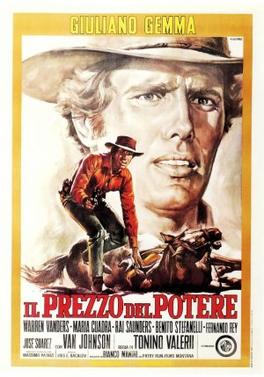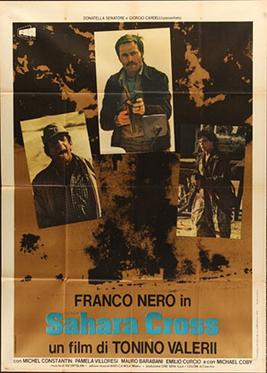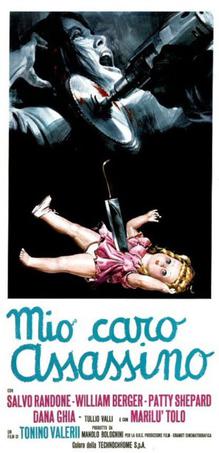Related Research Articles

My Name Is Nobody is a 1973 Italian/French/German international co-production comedy spaghetti Western starring Terence Hill and Henry Fonda. The film was directed by Tonino Valerii and based on an idea by Sergio Leone.

The Price of Power is a 1969 Spaghetti Western directed by Tonino Valerii. The film stars Giuliano Gemma as the hero Bill Willer who tries to get revenge against the killers of his father while at the same time trying to prevent an assassination plot against president James Garfield in 1881.
Tonino Valerii was an Italian film director, most known for his Spaghetti Westerns. Tonino (Antonio) Valerii started his film career as an assistant director on Sergio Leone's A Fistful of Dollars, before moving on to direct by himself. Among his best-known films are Day of Anger (1967) The Price of Power (1969), My Dear Killer (1972), A Reason to Live, a Reason to Die (1972) and My Name Is Nobody (1973), starring Henry Fonda and Terence Hill.

Fabio Testi is an Italian actor. After growing up witnessing film work done around Lake Garda, Testi entered the sets of the film and began work as a stuntman and a double on set, where he worked as a stuntman on The Good, the Bad and the Ugly. Testi continued stunt work and getting roles in low budget genre films until he was cast in Vittorio De Sica's film The Garden of the Finzi-Continis. Following this film, Testi became a star in Italy, appearing in some artistic films by Giuseppe Patroni Griffi and Claude Chabrol. Testi also continued to work in poliziotteschi genre films in the 1970s as well as a few gialli, and gained infamy for his publicised relationships with actresses Ursula Andress and Charlotte Rampling.

Fernando Di Leo was an Italian film director and script writer. He made 17 films as a director and about 50 scripts from 1964 to 1985.

Luigi Cozzi is an Italian film director and screenwriter. At a young age, Cozzi became a fan of science fiction and began his career as an overseas correspondent for Western film magazines. After directing his first film The Tunnel Under the World, Cozzi befriended director Dario Argento and began working with him in film and television as well as directing his own features including Hercules as well as continuing work with Argento. In the 2010s, he returned to directing with the film Blood on Méliès' Moon.

A Girl Called Jules is a 1970 Italian drama film directed by Tonino Valerii.

Sahara Cross is a 1977 Italian action film directed by Tonino Valerii. It is the first Italian film to use steadicam.

Per il gusto di uccidere is the 1966 Italian Spaghetti Western film debut directed by Tonino Valerii. It is also the first film to use the camera system known as 2P. It was filmed in Almería. It is produced by Francesco Genesi, Vincenzo Genesi, Daniele Senatore, Stefano Melpignano and Jose Lopez Moreno, scored by Nico Massi and edited by Rosa G. Salgado.

Go Gorilla Go is a 1975 Italian poliziottesco film directed by Tonino Valerii.

My Dear Killer is a 1972 Italian-Spanish giallo film directed by Tonino Valerii and starring George Hilton, Marilù Tolo, Patty Shepard, Helga Line, Salvo Randone and William Berger. Some critics considered it "one of the best films in the thriller genre" and as "one of the best, most vibrant and well designed products of Italian giallo."

The Long Hair of Death is a 1964 Italian horror film directed by Antonio Margheriti. It stars British actress Barbara Steele in the roles of Helen Rochefort and Mary, Italian actor George Ardisson as Kurt Humboldt, and Polish actress Halina Zalewska in a dual role as Adele Karnstein and her daughter Lisabeth. It is set in a 15th-century feudal castle, and the nearby village.
Fabrizio De Angelis is an Italian director, screenwriter and producer.

Terror in the Crypt is a 1964 Italian-Spanish horror film directed by Camillo Mastrocinque. The screenplay was by Tonino Valerii and Ernesto Gastaldi, based on the 1872 novel Carmilla by Joseph Sheridan Le Fanu. It was the third film adaptation of the novel, following Carl Theodor Dreyer's Vampyr (1932) and Roger Vadim's Blood and Roses (1960).

Tex and the Lord of the Deep is a 1985 Western film co-written and directed by Duccio Tessari and starring Giuliano Gemma and William Berger. The film is an adaptation of the Tex comic series that were popular in Italy. Previously attempted to be made into a production in the late 1960s and early 1970s, the film was eventually made by Tessari who adapted the film from the comics originally to be a pilot for a television series.
Shatterer is a 1987 film directed by Tonino Valerii.
References
- 1 2 3 4 5 6 7 8 Curti 2016, p. 200.
- 1 2 3 Curti 2016, p. 129.
- 1 2 3 4 Curti 2016, p. 125.
- 1 2 Curti 2016, p. 171.
- 1 2 3 4 Curti 2016, p. 126.
- ↑ Curti 2016, p. 172.
- ↑ Hammer 2015, p. 686-688.
- ↑ Curti 2016, p. 161.
- ↑ Curti 2016, p. 162.
- ↑ Mues 1988, p. 61.
- ↑ Curti 2016, p. 186.
Sources
- Curti, Roberto (2016). Tonino Valerii: The Films. McFarland. ISBN 978-1476626185.
- Hammer, Langdon (2015). James Merill: Life and Art. Alfred A. Knopf. ISBN 978-0375413339.
- Mues, Ingeborg, ed. (1988). Fischer Film Almanach . 1988 (in German). Fischer Taschenbuch Verlag. ISBN 359624479X.